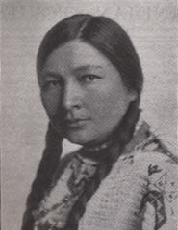|
|
Online Texts for Craig White's Literature Courses
|
|
|
selections from American Indian Stories (index)
by Zitkala-Sa (Gertrude Bonnin)
A DREAM OF HER GRANDFATHER
|
|
[1] Her grandfather was a Dakota "medicine man." Among the Indians of his day he was widely known for his successful healing work. He was one of the leading men of the tribe and came to Washington, D.C., with one of the first delegations relative to affairs concerning the Indian people and the United States government.
[2] His was the first band of the Great Sioux Nation to make treaties with the government in the hope of bringing about an amicable arrangement between the red and white Americans. The journey to the nation's capital was made almost entirely on pony-back, there being no railroads, and the Sioux delegation was beset with many hardships on the trail. His visit to Washington, in behalf of peace among men, proved to be his last earthly mission. From a sudden illness, he died and was buried here.
[3] When his small granddaughter grew up she learned the white man's tongue, and followed in the footsteps of her grandfather to the very seat of government to carry on his humanitarian work. Though her days were filled with problems for welfare work among her people, she had a strange dream one night during her stay in Washington. The dream was this: Returning from an afternoon out, she found a large cedar chest had been delivered to her home in her absence. She sniffed the sweet perfume of the red wood, which reminded her of the breath of the forest,—and admired the box so neatly made, without trimmings. It looked so clean, strong and durable in its native genuineness. With elation, she took the tag in her hand and read her name aloud. "Who sent me this cedar chest?" she asked, and was told it came from her grandfather.
[4] Wondering what gift it could be her grandfather wished now to confer upon her, wholly disregarding his death years ago, she was all eagerness to open the mystery chest.
[5] She remembered her childhood days and the stories she loved to hear about the unusual powers of her grandfather,—recalled how she, the wee girl, had coveted the medicine bags, beaded and embroidered in porcupine quills, in symbols designed by the great "medicine man," her grandfather. Well did she remember her merited rebuke that such things were never made for relics. Treasures came in due time to those ready to receive them.
[6] In great expectancy, she lifted the heavy lid of the cedar chest. "Oh!" she exclaimed, with a note of disappointment, seeing no beaded Indian regalia or trinkets. "Why does my grandfather send such a light gift in a heavy, large box?" She was mystified and much perplexed.
[7] The gift was a fantastic thing, of texture far more delicate than a spider's filmy web. It was a vision! A picture of an Indian camp, not painted on canvas nor yet written. It was dream-stuff, suspended in the thin air, filling the inclosure of the cedar wood container. As she looked upon it, the picture grew more and more real, exceeding the proportions of the chest. It was all so illusive a breath might have blown it away; yet there it was, real as life,—a circular camp of white cone-shaped tepees, astir with Indian people. The village crier, with flowing head-dress of eagle plumes, mounted on a prancing white pony, rode within the arena. Indian men, women and children stopped in groups and clusters, while bright painted faces peered out of tepee doors, to listen to the chieftain's crier.
[8] At this point, she, too, heard the full melodious voice. She heard distinctly the Dakota words he proclaimed to the people. "Be glad! Rejoice! Look up, and see the new day dawning! Help is near! Hear me, every one."
[9] She caught the glad tidings and was thrilled with new hope for her people.
![]()
End of "A Dream of her Grandfather"
> "The Widespread Enigma concerning Blue-Star Woman"


